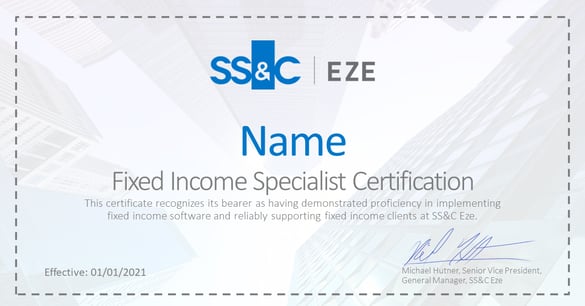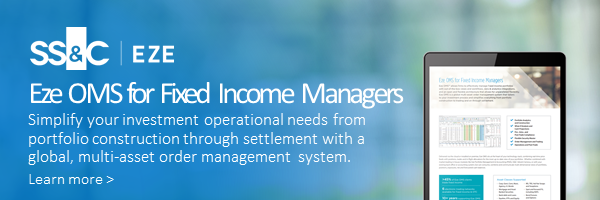Provider Fixed Income Competency—Beyond the Software
For those who’ve been in the investment management space for a while, it’s no secret that investment applications tend to weigh toward either an equity or fixed income competency. This manifests well beyond the capabilities baked into a provider’s software. It’s typically reflected not only in their sales pitch (where they have an opportunity to put their best foot forward) but, perhaps most glaringly, in their client services organization.
Seeing Through the Smoke: Shopping for a Platform to Manage Your Diverse Business
With strong tailwinds propelling investment managers to leverage an increasingly diverse range of asset classes in a regulation-dense environment, investment software and service providers are often caught scrambling to re-position themselves as having obtained dual-competency in equity and fixed income instruments. For investment managers, attempting to see reality through the potential smoke and mirrors of a marketing and sales strategy can be a challenge. In such circumstances, how can an investment manager trust that the expertise demonstrated in a sales pitch extends to both the product and the service teams?
“Doing Fixed Income”—Putting Their Money Where Their Mouth Is
When a software vendor claims to “do fixed income,” it should cause some skepticism. Catering to such a broad universe of fixed income asset classes requires a vast diversity and depth of competencies. This means the vendor needs to really put their money where their mouth is to deliver on that guarantee. They can do this by investing heavily in their applications’ fixed income capabilities, and just as importantly, if not more so, committing to hire and develop talented services staff to partner with clients on a professional level during the initial onboarding experience and beyond. To gauge whether a provider has invested in this level of expertise, an investment manager will need to peel back the organizational onion and say, “prove it!”
Gauging Vendor Fixed Income Competency: 5 Key Areas of Expertise
At SS&C Eze, approximately half of Eze Investment Suite clients trade fixed-income products, and our decade of learning in this area has left us with many valuable lessons. Our conversations with investment managers, including their (sometimes horror) stories of vendor searches, have given us an understanding of the 5 key areas of expertise fixed income managers should look for to determine whether a platform and service provider has the necessary investment and commitment to earn the business of a fixed income-inclusive book:
1. Service professionals who understand fixed income instruments and their use
There’s nothing more frustrating than starting a project to onboard new asset classes or a new book and quickly realizing that the “product expert” you’re speaking to is treating the fixed income portion the same way they would equity. The time spent teaching your client service representative Bonds 101 is time that could be better spent on alpha-generating tasks.
Your provider should take responsibility for cultivating software expertise in the context of your business. An easy test is to have an informal conversation with a software provider’s solutions architect. Talk through the gamut of fixed income asset classes you’re planning for, and observe whether they have recommendations for you, rather than simply asking how you want to see your bonds.
At SS&C Eze, to continue delivering both the software and contextual insights our clients desire, as well as top-caliber consulting talent, we formalized our culture of fixed income expertise through the SS&C Eze Fixed Income Specialist Certification. This is an intensive series of courses developed with fixed income experts from around the globe. Through this program, employees will explore relevant market and industry factors, dive deep into the art and science behind fixed income instruments and investment strategies, learn product implementation best practices, and prove their mastery for completion. Once certified, employees are subject matter experts – go-to resources for both clients and internally, where they'll lead critical projects, train colleagues, and consult on strategic initiatives related to fixed income.

2. Relationships that give them a complete understanding of what fixed income portfolio managers want
The world of fixed income can be a deep, dark cave for an equity-centric provider. It takes real commitment to building relationships with career fixed income portfolio managers and analysts to start to grasp how they frame their world. Long before technical systematic strategies were all the rage in the equity world, fixed income portfolio managers were turning the balance of risk controls and duration-weighting into a careful science to create their ideal portfolio. Over the years, thoughtful fixed-income portfolio managers have continued to find success in evolving their secret sauce while generally maintaining some core principles; however, software vendors will never understand the way a modern portfolio manager views their domain without putting in the time and building the relationships.
At SS&C Eze, balancing the equity and fixed income demands of our clients is central to our value proposition as an all-in-one application provider. One such relationship we maintain is with the talented fixed income team at Eleva Capital, LP, whose generous partnership has led to valuable takeaways that have made their way into our products, our “Best Practice” training programs for our services representatives, and even impacted how we present our capabilities to prospective clients.
3. Awareness of how fixed income traders find liquidity and offering the tools to help them source it
The bane, but also the competency, of a talented fixed income trader will always be the reliable sourcing of liquidity. And these traders are looking for a provider who gets that and joins them on their hunt. This is why, at SS&C Eze, we pride ourselves on our open architecture and continue to partner with top liquidity providers as well as make it easy for traders to review their history to quickly recall their best sources. For providers with backgrounds predominantly in a world where their clients work to find the best fruits in a voluminous equity cornucopia, it’ll be a continuous challenge to understand where the focus and value lie when supporting those executing a fixed income strategy.
4. Intentional development and fixed income consideration in every component
FinTech for investment managers is a highly competitive industry and beset with the age-old opportunity/cost quandary. Every vendor claims to invest heavily in their products. Technology is a provider’s most tangible representation of its investment and where they see the most value for their client base. However, fixed income competency isn’t achieved through an impassioned statement from a CEO, a company hackathon, or even a year of sustained effort. It requires years of deliberate development and the humility to heed the expert feedback and direction of a client base that is highly skilled in their craft.
At SS&C Eze, our partnership approach to client service and development focuses on building and nurturing deep relationships with clients and gathering and acting on feedback from the front-line. Additionally, over the past decade, we’ve found that offering a true fixed-income product requires consideration through every component of the product. From security master data structure to real-time out-of-the-box calculations, to the ability to model and analyze the portfolio using fixed income metrics, to ensuring our cash ladder accommodates instrument cash flow, and much more. If you’re a fixed income investment manager and want to know if your provider’s product was designed with you in mind – ask what the difference is between your product experience and that of an equity manager.
5. Use of the Crystal Ball – What’s next for the space?
Who knew that the top providers for fixed income software and services would also be soothsayers? But it’s true, in a sense. These providers are not only responsive to the needs of their existing and prospective clients, as well as the market as a whole, but proactive in anticipating future needs. As more managers branch out into fixed income, and the strategies of new and incumbent managers deepen in complexity, the top provider firms will be thinking ahead and building today what their clients will need a year from now.
At SS&C Eze, we predict that the future of investment management technology will include big data and macro topics, the further electronification of fixed income trading, a slew of small vendor consolidations, and big strategic partnerships. One area we’re particularly excited about is interoperability – the concept that applications should be able to network and share key information to collectively produce additional value for the end user. What is your provider doing to lead the fixed income technology space?
What Does It Mean to “Do Fixed Income?”
What does it mean to “do fixed income?” While the 5 key areas of expertise outlined above offer an in-depth look at the various characteristics a true fixed-income provider should have, our client-partner Fortlake Asset Management summarized it best – a product that has “advanced trading and portfolio management capabilities across asset classes” and a client services team that understands your business and delivers “the tools [you] need to pursue a variety of fixed income strategies.”
At SS&C Eze, we define “doing fixed income” as deep knowledge and laser-focus on real client needs, accompanied by a broad, sustained investment to deliver on the needs of our fixed income users today, tomorrow, and a year from tomorrow.
This piece was written with contributions from Adam De Rose.
If you’re interested in learning about SS&C Eze's Eze OMS for fixed income managers, click here:



